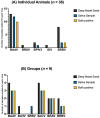Development of a Novel, Non-Invasive Saliva Sampling Method for the Detection of Bovine Respiratory Viruses
- PMID: 40711297
- PMCID: PMC12300326
- DOI: 10.3390/vetsci12070637
Development of a Novel, Non-Invasive Saliva Sampling Method for the Detection of Bovine Respiratory Viruses
Abstract
Bovine respiratory disease (BRD) is one of the most significant health issues in cattle populations worldwide, leading to great economic losses and animal suffering [...].
Keywords: bovine respiratory disease (BRD); non-invasive diagnostics; respiratory viruses; saliva sampling method.
Conflict of interest statement
Mandy Eibisch and Andrea Lindner are employees (and owns stock) in BioCheck-Laboratory for Veterinary Diagnostics and Environmental Hygiene GmbH. The remaining authors have no conflict of interest to declare. The funders had no role in the design of the study; in the collection, analyses, or interpretation of data; in the writing of the manuscript; or in the decision to publish the results.
Figures




Similar articles
-
Nasal pathobiont abundance is a moderate feedlot-dependent indicator of bovine respiratory disease in beef cattle.Anim Microbiome. 2025 Mar 15;7(1):27. doi: 10.1186/s42523-025-00387-y. Anim Microbiome. 2025. PMID: 40087791 Free PMC article.
-
Systematic Review of the Diagnostic Accuracy of Haptoglobin, Serum Amyloid A, and Fibrinogen versus Clinical Reference Standards for the Diagnosis of Bovine Respiratory Disease.J Vet Intern Med. 2016 Jul;30(4):1356-68. doi: 10.1111/jvim.13975. Epub 2016 Jun 3. J Vet Intern Med. 2016. PMID: 27255433 Free PMC article.
-
Diagnostic accuracy of clinical illness for bovine respiratory disease (BRD) diagnosis in beef cattle placed in feedlots: A systematic literature review and hierarchical Bayesian latent-class meta-analysis.Prev Vet Med. 2016 Dec 1;135:67-73. doi: 10.1016/j.prevetmed.2016.11.006. Epub 2016 Nov 9. Prev Vet Med. 2016. PMID: 27931931
-
Supplementing a Bacillus-based probiotic to high-risk stocker cattle.J Anim Sci. 2024 Jan 3;102:skae209. doi: 10.1093/jas/skae209. J Anim Sci. 2024. PMID: 39051136 Free PMC article.
-
Antibiogram use on dairy cattle for bovine respiratory disease: A repeated cross-sectional study evaluating antimicrobial susceptibility of Pasteurella multocida and Mannheimia haemolytica.J Dairy Sci. 2025 Jul;108(7):7401-7414. doi: 10.3168/jds.2025-26441. Epub 2025 Apr 28. J Dairy Sci. 2025. PMID: 40306431
References
-
- Dubrovsky S.A., van Eenennaam A.L., Aly S.S., Karle B.M., Rossitto P.V., Overton M.W., Lehenbauer T.W., Fadel J.G. Preweaning cost of bovine respiratory disease (BRD) and cost-benefit of implementation of preventative measures in calves on California dairies: The BRD 10K study. J. Dairy Sci. 2020;103:1583–1597. doi: 10.3168/jds.2018-15501. - DOI - PubMed
Grants and funding
LinkOut - more resources
Full Text Sources

